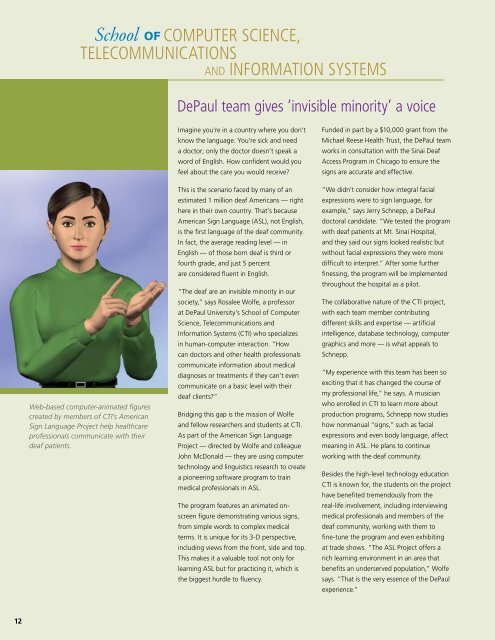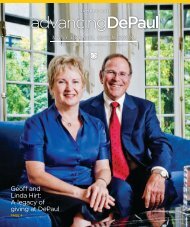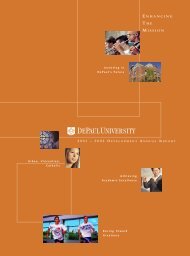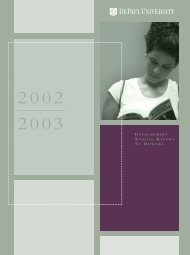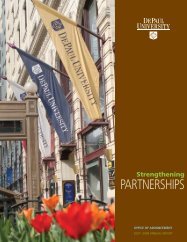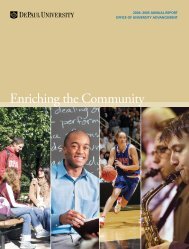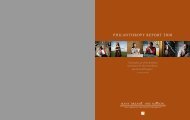fulfilling our - Alumni - DePaul University
fulfilling our - Alumni - DePaul University
fulfilling our - Alumni - DePaul University
Create successful ePaper yourself
Turn your PDF publications into a flip-book with our unique Google optimized e-Paper software.
12<br />
School OF COMPUTER SCIENCE,<br />
TELECOMMUNICATIONS<br />
AND INFORMATION SYSTEMS<br />
Web-based computer-animated figures<br />
created by members of CTI’s American<br />
Sign Language Project help healthcare<br />
professionals communicate with their<br />
deaf patients.<br />
<strong>DePaul</strong> team gives ‘invisible minority’ a voice<br />
Imagine you’re in a country where you don’t<br />
know the language. You’re sick and need<br />
a doctor; only the doctor doesn’t speak a<br />
word of English. How confident would you<br />
feel about the care you would receive?<br />
This is the scenario faced by many of an<br />
estimated 1 million deaf Americans — right<br />
here in their own country. That’s because<br />
American Sign Language (ASL), not English,<br />
is the first language of the deaf community.<br />
In fact, the average reading level — in<br />
English — of those born deaf is third or<br />
f<strong>our</strong>th grade, and just 5 percent<br />
are considered fluent in English.<br />
“The deaf are an invisible minority in <strong>our</strong><br />
society,” says Rosalee Wolfe, a professor<br />
at <strong>DePaul</strong> <strong>University</strong>’s School of Computer<br />
Science, Telecommunications and<br />
Information Systems (CTI) who specializes<br />
in human-computer interaction. “How<br />
can doctors and other health professionals<br />
communicate information about medical<br />
diagnoses or treatments if they can’t even<br />
communicate on a basic level with their<br />
deaf clients?”<br />
Bridging this gap is the mission of Wolfe<br />
and fellow researchers and students at CTI.<br />
As part of the American Sign Language<br />
Project — directed by Wolfe and colleague<br />
John McDonald — they are using computer<br />
technology and linguistics research to create<br />
a pioneering software program to train<br />
medical professionals in ASL.<br />
The program features an animated onscreen<br />
figure demonstrating various signs,<br />
from simple words to complex medical<br />
terms. It is unique for its 3-D perspective,<br />
including views from the front, side and top.<br />
This makes it a valuable tool not only for<br />
learning ASL but for practicing it, which is<br />
the biggest hurdle to fluency.<br />
Funded in part by a $10,000 grant from the<br />
Michael Reese Health Trust, the <strong>DePaul</strong> team<br />
works in consultation with the Sinai Deaf<br />
Access Program in Chicago to ensure the<br />
signs are accurate and effective.<br />
“We didn’t consider how integral facial<br />
expressions were to sign language, for<br />
example,” says Jerry Schnepp, a <strong>DePaul</strong><br />
doctoral candidate. “We tested the program<br />
with deaf patients at Mt. Sinai Hospital,<br />
and they said <strong>our</strong> signs looked realistic but<br />
without facial expressions they were more<br />
difficult to interpret.” After some further<br />
finessing, the program will be implemented<br />
throughout the hospital as a pilot.<br />
The collaborative nature of the CTI project,<br />
with each team member contributing<br />
different skills and expertise — artificial<br />
intelligence, database technology, computer<br />
graphics and more — is what appeals to<br />
Schnepp.<br />
“My experience with this team has been so<br />
exciting that it has changed the c<strong>our</strong>se of<br />
my professional life,” he says. A musician<br />
who enrolled in CTI to learn more about<br />
production programs, Schnepp now studies<br />
how nonmanual “signs,” such as facial<br />
expressions and even body language, affect<br />
meaning in ASL. He plans to continue<br />
working with the deaf community.<br />
Besides the high-level technology education<br />
CTI is known for, the students on the project<br />
have benefited tremendously from the<br />
real-life involvement, including interviewing<br />
medical professionals and members of the<br />
deaf community, working with them to<br />
fine-tune the program and even exhibiting<br />
at trade shows. “The ASL Project offers a<br />
rich learning environment in an area that<br />
benefits an underserved population,” Wolfe<br />
says. “That is the very essence of the <strong>DePaul</strong><br />
experience.”


